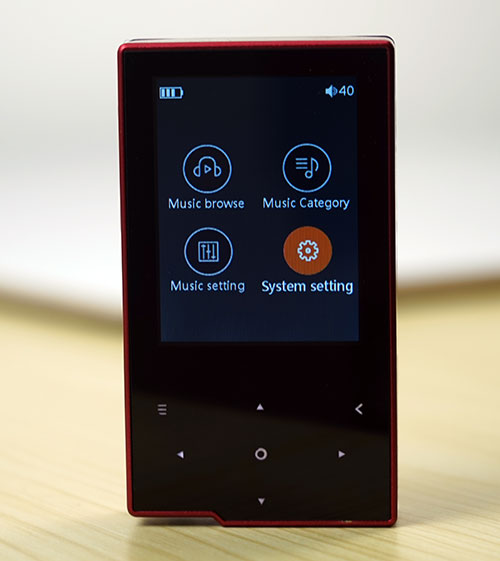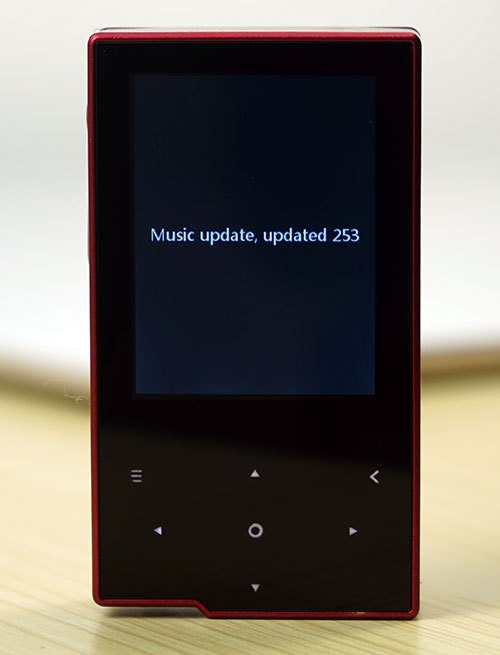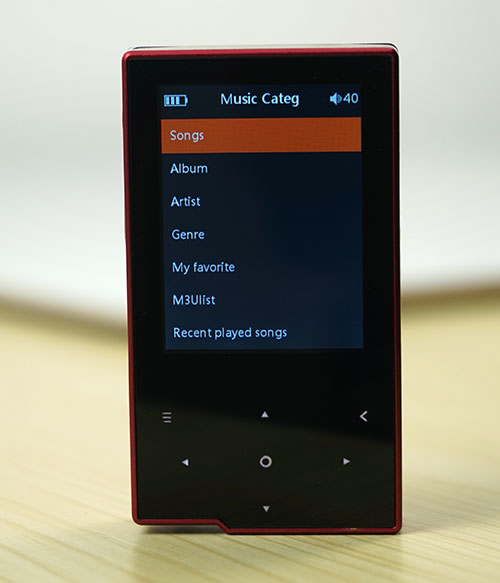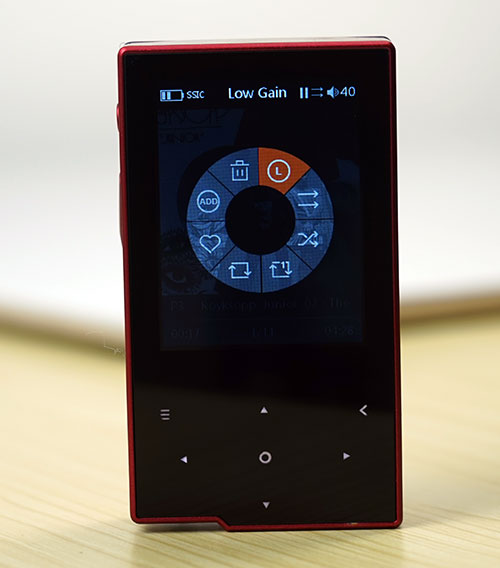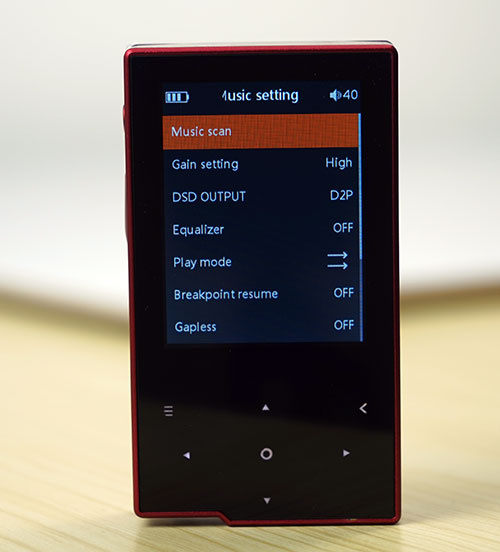Software
Note the firmware edition used for this review was fw1.05 (Beta)
Platform
The AP60 uses a system on a chip or SOC platform for its software delivery (Ingenics XBurst1). For those using the Cayin N3, or the FiiO X3ii, X5ii the architecture is actually very similar and follows much the same UI functionality. In fact, this SOC platform is widely used on entry level DAP models in one form or another due to its matured stability and excellent speed.
The OS is not app or WiFi capable, it is not as advanced as the touch-based X5iii Android platform, nor is it a Linux type platform such as you see on the X1 2nd gen, but it is not as power or memory hungry as the touch-based solutions. This is a pure DAP platform through with additional BT functionality and OTG functionality.
Speed
Boot Times
Boot up time on the AP60 is fast. Not an instant on thing mind you, but at around 5-6 seconds to the home screen is one of the fastest DAP loading times of this OS I have seen to date. Put it this way, the N3 has a similar OS, same Ingenics XBurst1 chip, and boots up in 15 seconds and the X1 2nd Gen boots up in 10 seconds. The FiiO X3 and X5 2nd gen took around 8-10 seconds and I thought that was very good also.
Power down time is also pretty quick at 1-2 seconds, a little quicker than the competing DAPs but the only issues I have here is the length of time it takes pressing down the power button before the power off cycle begins which is almost 3 seconds.
Menu cycling is also pretty instant also with minimal lag between track selection and the audio starting. Moving from menu to menu option was also quick enough and the capacitive buttons, when hit accurately, were fairly responsive.
Scanning
Scanning speed and accuracy are in par with the Cayin N3 and superior to the FiiO X1 2nd Gen though not as fast as the Android-based players such as the i5 and X5iii. I actually used the same library 64GB Card as the N3 during the N3 to test the speed of the AP60 media library and it took approximately 60-63 seconds for 2400 16BIT FLAC tracks so it can match the processing power of the N3 no problem.
As a working comparison, the FiiO X1 2nd gen takes a whopping 10 minutes to load a similar level of lossless files and tag them into the OS database, whereas the Cayin i5 takes just 20-25 seconds.
Scanning times was equally impressive though again not quite as fast as the i5. 2400 16BIT Flac tracks loaded onto a 64Gb Sansdisk microSD card took approximately 63 seconds to be scanned and entered into the Music Category database.
Media Management
The OS used by the AP60 is very familiar to Fiio, Cayin and Shanling DAP users, especially when it comes to media management. On the home screen of the AP60 you have 3 specific media management options; music browse, music category, and music setting. There are some minor management options in the settings option also such as folder skipping. Unlike both FiiO and Cayin, there is no Playing Now category, to access that type of option on the AP60 you have to hit the top right return button from the home screen.
Music Browse & Music Category
Both essentially do the same thing and that is to allow you to browse your music files and select the desired track you wish to play. They differ though in terms of how the media is filed and presented. The Music Category is your classic tag driven media management tool and will show up once you have opted to update your music Library.
The weird thing I have always found about this OS is that the updating or scanning option is not in the Category menu but in the Browse menu where the tag driven database is not accessible. In other DAPs, this is often referred to as the Music Library option.
Category Titles
Once your database is built (60-63 seconds for 2400 FLAC tracks) you can opt to drill down into your media via a simple list of options on the first page of the Category. These include ‘Songs’, ‘Album’, ‘Artist’, ‘Genre’, ‘My Favorite’, ‘M3UList’ and ‘Recently Played’ songs. All very familiar types of filters for this OS and normally very accurate in reading the tags also.
Genre Drill Down
The drill down organizational mapping of the Genre filter in the Music Category is the exact same as in every version of this OS which means thumbs down from me since I gave it thumbs down for the N3 and X1.
There is no subgrouping beyond the genre itself. If you have 1000 songs from different artists with one genre the OS will just show you 1000 songs in alphabetical order and no filtering for artist>album>song organization which I think is much easier. Thankfully there is a better drill down organization in the artist and album category.
Music Browse
The Music Browse is your basic file explorer option for memory cards and OTG flash disk or external powered hard drive sources. This is going to be incredibly useful if you are OCD on file naming convention and folder management or entirely useless if you rely 100% on tag management. It does, however, avoid the need to update your library since it is a live display of what’s on your memory cards.
Settings
There are two main settings controls on the AP60. The Music Setting category and the System setting category. Both can be accessed via the home menu screen from boot up but some aspects of the Music Setting category can be called “on the fly” from the playback screen menu.
‘On the Fly’ Settings
During playback, you can press the top right capacitive button to bring up a short list of actionable items that overlays the screen like a pie chart. Options include gain control, track deletion, order of play, playlist tweaking and adding to your favorites.
Users of this OS will be familiar with these options and my main concern is still the amount of time it shows on the screen before it disappears which is too quick. If Hidizs have a future firmware update it would be easier to change this action to a “button to call up the list” and the return button to terminate the list when finished to give more time to scroll through the options.
Music Settings
Accessible from the home page, the music settings category controls the majority of the tonal tweaks you can apply to your tracks during playback. These include options such as high or low gain, DSD output in either DoP or D2P, a customizable 10-band EQ with presets, gapless and volume controls.
It also contains the option to scan and update your music database. There are no options for lyrics, alternative analog or SPDIF settings since the AP60 has none and the digital filters setting is not present either due to the AP60 being designed on a fixed single filter.
System Settings
These are generally the core settings of the AP60 itself and covers most operational features such as language, themes, LCD brightness, and power related options such as power saving shutdown scheduling and scheduled power offs.
You can also elect to upgrade the firmware from this the system settings and check the existing firmware from within the system settings. For those wishing to use the AP60 as a DAC, you can also control that feature from within this category. You can also turn on the BT from within the system settings and connect and pair to the BT source of your choice.
Connectivity
There are two main options on the AP60 for connectivity via this OS and that is wired (OTG and USB-DAC) and wireless (BT 4.0 aptX). This is fairly consistent with the N3 and X1, however, it does not offer any SPDIF or line level analog output, unlike those two DAPs. The AP60 only has a headphone jack out for analog.
Wired
OTG
Wired, including OTG is heavily integrated already into the AP60 OS and will automatically show up as a searchable drive under the Music Library/OTG option the moment you plug in your flash drive or HDD. Any OTG cable will work so long as it is terminated with micro-USB. These are cheap and easy to acquire costing less than a $1 in most outlets.
Wireless
Bi-Directional Bluetooth
The AP60 uses the same very cool bi-directional BT connectivity as the Cayin N3 as well as having the capability of delivering aptX 4.0 level BT signal. The FiiO X1 2nd Gen does not have apt-X so this is a big plus for the AP60 at this price point.
Limited Control
However, unlike the N3, the AP60 cannot control playback from the source due to the lack of physical buttons. The capacitive buttons will not allow you to track select, fast forward or rewind and the physical volume control only controls the AP60’s own internal amp. That sorts of makes the bi-directional BT services a bit gimped because you cannot be that far away from the source if you want to skip tracks or pause etc.
Page 3: Sound, Matching & Comparisons





